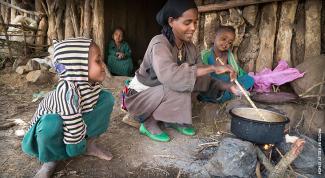OVERVIEW
Ethiopia made remarkable progress in reducing child stunting (57.4 to 36.8 percent), child wasting (12.4 to 7 percent), and child underweight levels (41.8 to 21.3 percent) over the last two decades. Sustained economic growth, strong pro-poor spending by the Government of Ethiopia, and health and agriculture extension systems all contributed to this success. Nonetheless, Ethiopia is not on track to meet the global World Health Assembly targets by 2025. The recent conflict in northern Ethiopia, governance challenges, and natural disasters have also reversed some of the progress achieved over the last two decades. Progress on infant and young child feeding practices is mixed, and children’s dietary diversity remains one of the lowest in Africa (13.5 percent in 2019) .
In conjunction with the Feed the Future Initiative and other programs, USAID is committed to investing in multi-sectoral nutrition programming in Ethiopia, which focuses on good maternal nutrition, optimal breastfeeding, complementary feeding, and key hygiene actions to reduce the numbers of malnourished women and children. To enable increased consumption of healthy diets, we invest in agriculture and food systems to improve the availability, affordability, desirability, and convenience of diverse, safe, nutritious foods year round. We also invest in sustainable water and sanitation systems to facilitate good hygiene. If disaster strikes, we are on the ground with our partners delivering therapeutic foods in response and restoring critical health, agriculture, and water services.
USAID also provides technical assistance in developing national policy, strategy, programs, guidelines, and improving the quality and access to essential health and nutrition services, and we work with hospitals and health centers in Ethiopia to provide nutrition services to women and children. We enhance nutrition-related activities under the Government of Ethiopia's Productive Safety Net Program (PSNP) with a focus on improving the quality of health services for pregnant and lactating mothers, raising awareness of healthy nutrition practices, improving water and sanitation access, and harmonizing activities with the Ethiopian Government's health and nutrition initiatives. Finally, USAID builds the capacity of disaster risk management institutions to prepare for shocks and improve the quality and timeliness of responses, thus preventing spikes in acute malnutrition and other related morbidity.
PRIORITIES
The new Feed the Future Ethiopia Community Nutrition activity will improve the nutritional status of women and young children in Ethiopia by improving nutritional practices and demand for services in local communities; improving the quality of nutrition services available in these communities; and improving capacity for coordination among nutrition stakeholders across sectors. The activity will focus on the first 1,000 days, a critical window of opportunity for child growth and development, to reduce undernutrition among children.
Feed the Future Ethiopia Transforming Agriculture works to make Ethiopia’s food and agriculture systems more competitive, inclusive, sustainable, and resilient in order to increase access to healthy diets, particularly for women and children. To do so, it will increase the availability, affordability (primarily by increasing incomes), convenience, and desirability of safe, diverse, nutritious foods, across the Feed the Future geographic zone of influence.
Feed the Future Ethiopia Resilience in Pastoral Areasimproves local-level disaster risk management (DRM), livestock and crop productivity, income generation, and nutrition and hygiene practices for pastoralist and agro-pastoralist populations. The nutrition component focuses on social and behavior change communications, women’s economic empowerment, and access to nutrient-dense foods for adolescent girls, women of reproductive age, and children under 2.
The Feed the Future Ethiopia Highlands Resilience Activity and the Resilience and Food Security Activities support chronically food insecure households to weather shocks and graduate from the Ethiopia’s Productive Safety Net Program through integrated agriculture, livelihoods, nutrition, and WASH interventions, in addition to cash or in-kind food transfers. The activities encourage pregnant and lactating women to use available nutrition services and promote nutrition-sensitive public works, such as community-based childcare centers and health post construction.

Kelley Lynch
